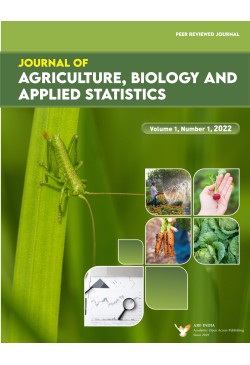
Journal of Agriculture, Biology and Applied Statistics
Frequency :Bi-Annual
ISSN :2583-4185
Peer Reviewed Journal
State of the Art in COVID-19 in the SAARC Countries and China using BATS,TBATS, Holt's Linear and ARIMA Model
Corona Virus is the biggest global health disease and it is an epidemic according to the World Health Organization (WHO). The purpose of this paper is to identify the best fitted model among BATS, TBATS, Holt's linear trend and ARIMA based on the minimum value of AIC and MAE and forecasting data about corona virus from SAARC and China countries. Cumulative daily data about covid19 has been collected from 3 January, 2020 to 10 March, 2021in the world health organization (WHO) in both infection and death cases. BATS, TBATS, Holt's linear trend and ARIMA models with some selection criteria are used to forecast the next Covid-19 situation in SAARC and China usin R Language Program. According to Akaike Information Criterion (AIC), Holt's linear trend model is the best model and better than both BATS and TBATS models in both infection and death cases. Depending on MAE criteria, ARIMA is the best fitted model for Nepal, Pakistan, Sri Lanka, and Bangladesh countries for both death and infection cases while Holt is the best fitted model for both India and Myanmar countries in both cases. On the other hand, BATS is the best fitted model for both death and infection cases in China.
Keywords: ARIMA,BATS, BATS, Holts Linear, MAE, AIC, COVID-19, Forecasting.
Pradeep Mishra, Mostafa Abotaleb, Kadir Karakaya, Amr Mostafa, Hynur Yonar, Hazhar Talaat Abubaer Blbas, Umme Habibah Rahman and S S Das. (2022). State of the Art in COVID-19 in the SAARC Counties and China using BATS,TBATS, Holt's Linear and ARIMA Model. Journal of Agriculture, Biology and Applied Statistics. Vol. 1, No. 1, pp. 1-24.
A Comparative Study between (ARIMA - ETS) Models to Forecast Wheat Production and its Importance's in Nutritional Security
Modeling and Forecasting of Producer Price Index (PPI) of Cheese Manufacturing Industries
Role of Probability Models for Enhancing the Information of Temperature and Relative Humidity in Hoshangbad
Kadir Karakaya & Vikas Jain. (2022). Role of Probability Models for Enhancing the Information of Temperature and Relative Humidity in Hoshangbad. Journal of Agriculture, Biology and Applied Statistics. Vol. 1, No. 1, pp. 51-61.
A DEA Analysis of Farm Efficiency of KVK Adopted and Non- Adopted Farms in Khargone District of Madhya Pradesh